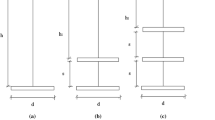Abstract
In this study, pullout performance tests were conducted on five prestressed ground anchors having different tendon bond and unbonded lengths. The tendon bond lengths of the tested anchors varied from 4 to 10 m, whereas the unbonded lengths were in the range of 8–16 m. The tests were performed separately on a dense, gravelly sandy soil slope with an inclination of 90° in Cottbus, Germany. The anchors were inclined downwards at an angle of 15° below the horizontal. The results indicated that three of the five anchors did not satisfy the acceptance criteria as outlined in DIN 4125 Standards. According to the acceptance criteria, the line that was composed of the elastic displacements of the unbonded length had to remain between two specific limit lines. Although the elastic displacements of the unbonded tendons were taken into account for the acceptance of the anchors, the length of the unbonded tendon did not have a significant effect on stability. The anchors having unbonded lengths of 8, 13, and 15 m failed, whereas the anchors with unbonded length of 9 and 16 m were accepted after the termination of the performance tests. However, the tendon bond length was proved to be an important parameter that contributed to the acceptance of the tested anchors. Test results indicated that anchors having tendon bond lengths longer or shorter than 6 m were rejected.








Similar content being viewed by others

References
Newton BJ (2012) Earth retaining systems using ground anchors, memo to designers 5–12. Caltrans Engineering Manuals, p 25
Sabatini PJ, Pass DG, Bachus RC (1999) Geotechnical engineering circular no. 4—ground anchors and anchored systems. Federal Highway Administration FHWA- IF-99-015, Washington DC, p 281
Hinks JL, Burton IW, Peacock AR, Gosschalk EM (1990) Post-tensioning Mullardoch Dam in Scotland. Water Power & Dam Constr 42(11):12–15
Bruce DA (1993) The stabilization of concrete dams by post-tensioned rock anchorages: the state of American practice. Anderson LR (ed) Geotechnical specifications publication, no. 35, geotechnical practice in dam rehabilitation. ASCE, New York, pp 320–332
Hsu SC, Chang CM (2007) Pullout performance of vertical anchors in gravel formation. Eng Geol 90(1–2):17–29
Gerwick BC (2008) Construction of prestressed concrete. In: Nawy EG (ed) Concrete construction engineering handbook, vol 11. CRC Press, Boca Raton, pp 1–62
Benmokrane B, Chekired M, Xu H, Ballivy G (1995) Behavior of grouted anchors subjected to repeated loadings in field. J Geotech Eng ASCE 121(5):413–420
Ostermayer H (1975) Construction, carrying behaviour and creep characteristics of ground anchors. Proceedings of Institution of Civil Engineers, London, pp 141–151
Hobst L, Zajic J (1977) Anchoring in rock. Developments in geotechnical engineering, 13. Elsevier Scientific, Amsterdam
Hanna TH (1982) Foundations in tension: ground anchors (series on rock and soil mechanics). Trans Tech Publications, McGraw-Hill, New York
Schnabel H Jr (1982) Tiebacks in foundation engineering and construction. McGraw-Hill Book Company, New York
Cao G, Zhang W, Hu J, Zhang K (2017) Experimental study on the long-term behaviour of RBPC t-beams. Int J Civ Eng. doi:10.1007/s40999-017-0227-2
Yang F, Cao S, Qin G (2017) Performance of the prestressed composite lining of a tunnel: case study of the Yellow River crossing tunnel. Int J Civ Eng. doi:10.1007/s40999-016-0124-0
Wichter L, Meininger W (2000) Verankerungen und vernagelungen im grundbau (anchors and soil nails in geotechnical constructions), 1st edn. Ernst & Sohn, Berlin, p 215
Ozhan HO (2004) The effect of tendon bond length of prestressed ground anchors to the stability of anchored retaining systems. M. Sc. Thesis, Bogazici University, Istanbul, p 184
Briaud JL, Powers WF, Weatherby DE (1998) Should grouted anchors have short tendon bond length? J Geotech Geoenviron Eng ASCE 124(2):110–118
Ozbakkaloglu T, Saatcioglu M (2009) Tensile behavior of FRP anchors in concrete. J Compos Constr ASCE 13(2):82–92
Zhang B, Benmokrane B, Chennouf A, Mukhopadhyaya P, El-Safty A (2001) Tensile behavior of FRP tendons for prestressed ground anchors. J Compos Constr ASCE 5(2):85–93
Vukotic G, Galindo JG, Soriano A (2013) The influence of bond stress distribution on ground anchor fixed length design. Field trial results and proposal for design methodology. In: Proceedings of the 18th international conference on soil mechanics and geotechnical engineering, Paris, pp 2119–2122
OPSS 942 (2009) Construction specification for prestressed soil and rock anchors. Ontario provincial standard specification, p 26
DIN 4125 (1990) Ground anchorages; temporary and permanent anchorages; design, construction and testing, Deutsches Institut für Normung
Ren FF, Yang ZJ, Chen JF, Chen WW (2010) An analytical analysis of the full-range behaviour of grouted rockbolts based on a tri-linear bond-slip model. Constr Build Mater 24(3):361–370
Showkati A, Maarefvand P, Hassani H (2016) An analytical solution for stresses induced by a post-tensioned anchor in rocks containing two perpendicular joint sets. Acta Geotech 11:415–432
Littlejohn GS (1980) Design estimation of the ultimate load-holding capacity of ground anchors. Ground Eng Found Publ, Essex, pp 25–39
Acknowledgements
The authors sincerely thank Prof. Dr. Lutz Wichter from Geotechnical Engineering Department of Brandenburg Technical University for providing the prestressed ground anchors and the equipment for conducting the pullout performance tests.
Author information
Authors and Affiliations
Corresponding author
Rights and permissions
About this article
Cite this article
Ozhan, H.O., Guler, E. Critical Tendon Bond Length for Prestressed Ground Anchors in Pullout Performance Tests Conducted in Sand. Int J Civ Eng 16, 1329–1340 (2018). https://doi.org/10.1007/s40999-017-0261-0
Received:
Revised:
Accepted:
Published:
Issue Date:
DOI: https://doi.org/10.1007/s40999-017-0261-0



